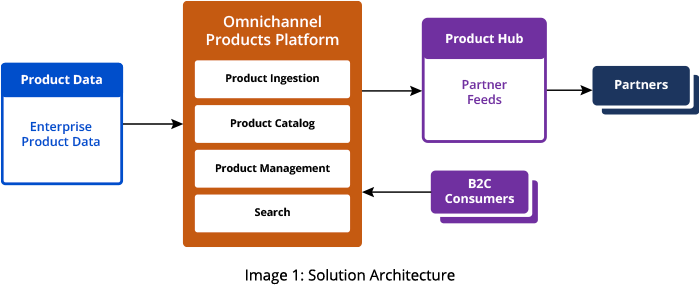Our Commerce team developed a comprehensive Omnichannel Product Platform (OCPP) for the company. The new platform offers a unified product catalog and data management capability that enables cross-platform omnichannel global product experiences across digital, retail, and wholesale partners.
The new platform has four main components:
- Product Ingestion: Stores API source data and performs transformations where needed. This component also confirms data against the API’s data model.
- Product Catalog: Omnichannel API handles customer-ready product data. This component also spins customer experience concerns to a separate API to improve performance.
- Product Management: Aggregates product data with offers and orders. This component is instrumental in creating channelized products.
- Search: Funnels search inquiry requests to the Gridwall search API.

Our Commerce team also created a hub that handles partner interactions. This hub performs a secure handshake and ensures messages are routed correctly to partners. It includes batch processes that facilitate bulk data transfer. There is also a set of web and mobile APIs to aggregate product data and content threads needed for customer experience analytics.
Key aspects of our solution include:
- A single comprehensive source of core data: Product data comes from a wide variety of sources in various formats. Previously, the company used several tools to bring the information together manually. Our solution automates product data ingestion and provides a unified source of comprehensive data.
- Expanded management of prices and content: Previously, the company’s PIM could only manage digital channel products. The new system expands the capabilities of PIM and moves pricing and content management to the right teams with a focus on omnichannel product consumption.
- Single partner data source with updated security model: Their previous system used different partner integration APIs, each with varying sets of fields and formats. Our team consolidated the existing data sources into a single unified stream with improved security.
- Single API presenting the right set of products based on the marketplace and channel: Not all products are appropriate for all markets and channels. Our solution ensures that the correct set of products appears based on intelligent decisions made about the marketplace and channel.
The new system offers over 19,000 active products, used by over 1,500 data consumers, with an average of 8.7 billion API calls per week at 99.99% availability.




